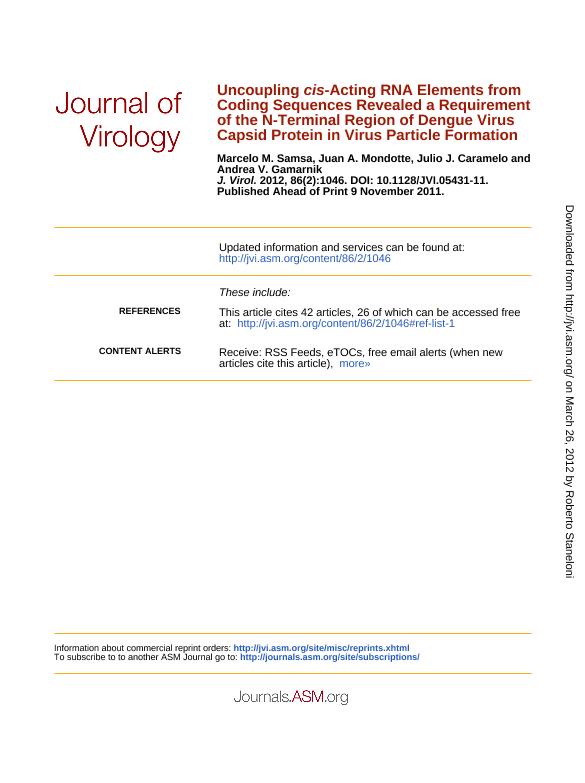Artículo
Uncoupling cis-Acting RNA elements from coding sequences revealed a requirement of the N-terminal region of dengue virus capsid protein in virus particle formation
Samsa, Marcelo Mario Alejandro ; Mondotte, Juan Alberto
; Mondotte, Juan Alberto ; Caramelo, Julio Javier
; Caramelo, Julio Javier ; Gamarnik, Andrea Vanesa
; Gamarnik, Andrea Vanesa
 ; Mondotte, Juan Alberto
; Mondotte, Juan Alberto ; Caramelo, Julio Javier
; Caramelo, Julio Javier ; Gamarnik, Andrea Vanesa
; Gamarnik, Andrea Vanesa
Fecha de publicación:
01/2012
Editorial:
American Society For Microbiology
Revista:
Journal Of Virology
e-ISSN:
1098-5514
Idioma:
Inglés
Tipo de recurso:
Artículo publicado
Clasificación temática:
Resumen
Little is known about the mechanism of flavivirus genome encapsidation. Here, functional elements of the dengue virus (DENV) capsid (C) protein were investigated. Study of the N-terminal region of DENV C has been limited by the presence of overlapping cis-acting RNA elements within the protein-coding region. To dissociate these two functions, we used a recombinant DENV RNA with a duplication of essential RNA structures outside the C coding sequence. By the use of this system, the highly conserved amino acids FNML, which are encoded in the RNA cyclization sequence 5'CS, were found to be dispensable for C function. In contrast, deletion of the N-terminal 18 amino acids of C impaired DENV particle formation. Two clusters of basic residues (R5-K6-K7-R9 and K17-R18-R20-R22) were identified as important. A systematic mutational analysis indicated that a high density of positive charges, rather than particular residues at specific positions, was necessary. Furthermore, a differential requirement of N-terminal sequences of C for viral particle assembly was observed in mosquito and human cells. While no viral particles were observed in human cells with a virus lacking the first 18 residues of C, DENV propagation was detected in mosquito cells, although to a level about 50-fold less than that observed for a wild-type (WT) virus. We conclude that basic residues at the N terminus of C are necessary for efficient particle formation in mosquito cells but that they are crucial for propagation in human cells. This is the first report demonstrating that the N terminus of C plays a role in DENV particle formation. In addition, our results suggest that this function of C is differentially modulated in different host cells
Palabras clave:
Dengue Virus
,
C Protein
,
Encapsidation
Archivos asociados
Licencia
Identificadores
Colecciones
Articulos(IIBBA)
Articulos de INST.DE INVEST.BIOQUIMICAS DE BS.AS(I)
Articulos de INST.DE INVEST.BIOQUIMICAS DE BS.AS(I)
Citación
Samsa, Marcelo Mario Alejandro; Mondotte, Juan Alberto; Caramelo, Julio Javier; Gamarnik, Andrea Vanesa; Uncoupling cis-Acting RNA elements from coding sequences revealed a requirement of the N-terminal region of dengue virus capsid protein in virus particle formation; American Society For Microbiology; Journal Of Virology; 86; 2; 1-2012; 1046-1058
Compartir
Altmétricas



